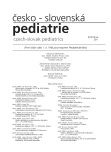Quality of life in children with allergic rhinitis
Authors:
M. Trpišová; J. Danišová; Ľ. Jakušová; P. Ďurdík
Authors‘ workplace:
Klinika detí a dorastu JLF UK a UNM, Martin
prednosta prof. MUDr. P. Bánovčin, CSc.
Published in:
Čes-slov Pediat 2011; 66 (5): 289-293.
Category:
Original Papers
Overview
Allergic rhinitis affects nearly a quarter of the population. Its presence during the 20th century has increased to 10 fold. In childhood and the age of 25 years background in allergy is more than 90 cases of non-infectious rhinitis.
The aim of our study
was to highlight the degree of burden in the various areas of life in a child suffering from allergic rhinitis and rhinoconjunctivitis.
The cohort enrolled 55 children aged 7–16 years with a confirmed diagnosis rhinitis or rhinoconjunctivitis. To collect empirical data, we used a questionnaire Mini – RQLQ (Rhinoconjunctivitis Quality of Life Questionnaire). The questionnaire is focused on leisure activities, everyday problems, nasal symptoms, eye symptoms and other symptoms. Results of studies show that children cause most problems nasal problems within everyday activities.
Conclusion:
To relieve the symptoms of allergic rhinitis respectively rhinoconjunctivitis is an important proper management of treatment that can contribute to improving the quality of life of children with perennial and season rhinitis.
Key words:
allergic rhinitis, quality of life, childhood
Sources
1. Passalacqua G, Ganonica GW, Baiardini I. Rhinitis, rhinosinusitis and quality of life in children. Pediatr Allergy Immunol 2007; 18(Suppl): 40–45.
2. Juniper E. Rhinitis quality of life. Allergol Immunol Clin 2001; 41 : 111–115.
3. Melzer EO, Blaiss MS, Derebery MJ. Burden of allergic rhinitis: Results from the pediatric allergies in America survey. J Allergy Clin Immunol 2009; 124: S43–70.
4. Bousquet J, Van Cauwenberge P, Khaltaev N, et al. Allergic rhinitis and its impact of asthma. Allergy 2002; 57 : 841–855.
5. Scadding GK. Allergic rhinitis in children. Pediatrics and Child Health 2008; 18 : 323–328.
6. Ferrer M, Almeida MM, Guizova M, Khanferyan R. Evaluation of treatment satisfaction in children with allergic disease treated with an antihistamine. Clin Drug Investig 2010; 30(1): 15–34.
7. Juniper E. Measuring health – related quality of life in rinitis. J Allergy Clin Immunol 1997; 99: S742–749.
8. Juniper E. Developement and validation of Mini Rhinoconjunctivitis Quality of Life Questionnaire. Clinical and Experimental Allergy 2000; 30 : 132–140.
9. Nathan RA. The burden of allergic rhinitis. Allergy Asthma Proc 2007; 28 : 3–9.
10. Stuck BA, Czajkowski J, Hagner AE, et al. Changes in daytime sleepiness, quality of life, and objective sleep patterns in seasonal allergic rhinitis: a controlled clinical trial. J Allergy Clin Immunol 2004; 113 : 663–668.
11. Lavie P, Gertner R, Zomer J, et al. Breathing disorders in sleep associated with „microarousals” in patients with allergic rhinitis. Acta Otolaryngol 1981; 92 : 529–533.
12. Berger WE. Allergic rhinitis in children: diagnosis and management strategies. Paediatr Drugs 2004; 6 : 233–250.
13. Gradman J, Wolters OD. Allergic conjunctivitis in children with asthma, rhinitis and eczema in a secondary outpatient clinic. Pediatr Alergy Immunol 2006; 17 : 524–526.
14. Craig TJ, McCann JL, Gurevich F, et al. The correlation between allergic rhinitis and sleep disturbance. J Allergy Clin Immunol 2004; 114: S139–145.
15. Bousquet J, Bodez T, Gehano P, et al. Implementation of Guidelines for Allergic Rhinitis in Specialist Practices. Int Arch Allergy Immunol 2009; 150 : 75–82.
16. Jeseňák M, Rennerová Z, Havlíčeková Z, Michnová Z, Pohanka V, Bánovčin P. Potravinová alergia v detskom veku a respiračný systém. Pediatria 2008; 3(3): 146–150.
17. Nosal S, Sutovska M, Nosalova G, Banovcin P, Sutovsky J, Franova S. Age-dependent changes of airway obstruction parameters. Journal of Physiology and Pharmacology 2007; 58(5): 493–500.
18. Jesenák M, Bánovcin P. Atopy patch test in the diagnosis of food allergy in children with atopic dermatitis. Acta Medica (Hradec Králové)/Universitas Carolina, Facultas Medica Hradec Králové 2006; 49(4): 199–201.
19. Jeseňák M, Babušíková E, Bánovčin P. Oxid uhoľnatý ako marker pľúcnych ochorení detského veku. Čes-slov Pediat 2006; 61(11): 651–656.
Labels
Neonatology Paediatrics General practitioner for children and adolescentsArticle was published in
Czech-Slovak Pediatrics

2011 Issue 5
- What Effect Can Be Expected from Limosilactobacillus reuteri in Mucositis and Peri-Implantitis?
- The Importance of Limosilactobacillus reuteri in Administration to Diabetics with Gingivitis
Most read in this issue
- Thromboembolism events in the newborn child from the point of view of present medicine
- The effect of mouth breathing on splanchnocraniums development in childhood
-
Influence of passive exposure to cigarette smoke on health and development of children in prenatal and postnatal period to 7 years of age.
Results of ELSPAC Study - Quality of life in children with allergic rhinitis
